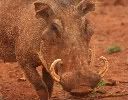Kenya wildlife populations in drastic decline
In Masai Mara, one of Africa’s most treasured parks, researchers have found significant, in some cases catastrophic, declines of wild grazing animals. In fifteen years six of seven hoofed animals—giraffes, warthogs, hartebeest, impala, topis and waterbucks—showed declines. The study published in the British Journal of Zoology confirms what has long been expected: wildlife populations in Masai Mara are plummeting due to increased competition with humans and livestock. The Masai Mara National Reserve lies over 1500 square kilometers in southwestern Kenya where it eventually links to Serengeti park in Tanzania. Heavily visited by tourists, the park is one of the best places in the world to see the famous wildebeest migration. Researchers from the International Livestock Research Institute (ILRI) conducted surveys of species every month for fifteen years, from 1989 to 2003. Giraffes fared the worse: dropping an astounding 95 percent in fifteen years. Warthog populations fell 80 percent. While hartebeest and impala dropped 76 percent and 67 percent respectively. “The situation we documented paints a bleak picture and requires urgent and decisive action if we want to save this treasure from disaster,” said Joseph Ogutu, the lead author of the study and a statistical ecologist at ILRI. “Our study offers the best evidence to date that wildlife losses in the reserve are widespread and substantial, and that these trends are likely linked to the steady increase in human settlements on lands adjacent to the reserve.”…
Famous Kenyan park experiencing large declines in wildlife
